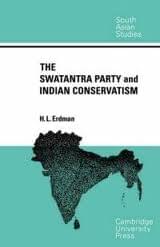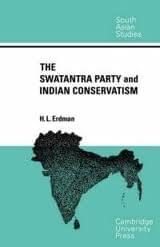Reviews
The Swatantra Party and Indian Conservatism by Howard L. Erdman
Karmasura
Nov 04, 2011, 02:26 PM | Updated Apr 29, 2016, 02:50 PM IST
Save & read from anywhere!
Bookmark stories for easy access on any device or the Swarajya app.


Conservative political formations across the world carry an enormous responsibility – cultural conceptions on issues of identity tend to be an important intellectual activity for them. A sense of perverted political correctness that currently dominates the intellectual landscape might have rendered it a pejorative term but identity politics has important functions to perform. It provides individuals a connectedness with the larger world and gives them an intrinsic sense of self worth. At a collective level, identity centric ideology and accompanying political mobilization is a useful instrument to preserve diversity in ideas, belief systems, philosophy and knowledge streams which otherwise tend to be subsumed by dominant religio-cultural strands of the day (in today’s age, this is the Christian West or Islam) which control narrative and levers of powers. Without the sense of history, preserved wisdom could be lost, and with it a sense of right or wrong and with it, a chance to improve on previous failures
Having said that, identity politics is not the only material conservative parties should focus on. The challenge is to judiciously blend ideation and articulation on issues of identity along with advocacy on issues of livelihood. In the perpetual conflict with the “modernizing” left that is played out in most democracies including in India, conservative parties are getting outflanked on ideological stands by the left. Given a lack of forceful and coherent counter narrative in areas like economic policy, statism, welfare policies and temple taxation, the left position tends to be seen as the consensual position. There is tremendous scope for developing thinking in these areas for rightist parties in India. While Conservative movement across the world have managed to achieve an ideological anchor by intelligently combining socio-cultural philosophy with definitive economic principles, lack of coherent economic ideology continues to be a huge lacunae for the conservative right in India
To study what an Indian conservative party should do and derive important lessons, understanding the rise and electoral eclipse of the Swatantra Party of India is mandatory. Book that we review in this post “The Swatantra Party and Indian conservatism” by Howard L. Erdman (published in 1967) has captured brilliantly the precepts, goals and policies of Swatantra Party. It makes an invaluable contribution in enhancing our understanding of Swatantra Party.
This book begins with a sterling attempt at defining conservatism, as an ideology that prefers stability and prefers change which is gradual and which maintains cultural continuity. A proponent of this ideology accepts change only after extensive proof and only if the moral price paid tends to be acceptable. Using this definitional principle of conservatism, the author identifies three strands of conservatism in Indian context: 1) aristocratic conservatives, of royalties and smaller principalities (many of them who were enlightened benevolent rulers) 2) aggressive brand of revivalist Hinduism that is committed to economic modernization, social change and to the creation of a modern nation-state with an emphasis on ‘Hinduism’ in religio-cultural matters and 3) supporters of both Hinduism in religio-cultural matters and that of a full blown idealized village model of lifestyle.
Erdman then proceeds to give the background of the Indian political scenario in which Swantatra party crystallized. Between 1947-1959, the various strands of Indian conservatives never coalesced into a single pan Indian political force. And given the near complete stranglehold of Nehruvian Congress, there was no alternative national political party. Conservative landscape was essentially dotted with plethora of marginal political outfits that were based on caste loyalties, enormous influence of aristocrats or groups that fought spiritedly against land reform legislations. Except for the Jan Sangh, no other alternative approximated the structure of a party. Political outfits on the conservative arena included the Janata Party of Bihar, Gantantra Parishad of Orissa, the Hindu Mahasabha and the Ram Rajya Parisha which postulated a return to the village centric model of a society. Hindu Mahasabha represented a firebrand, revivalist strand and the Janata Party of Bihar as well as the Gantantra Parishad had elements of the aristocracy infused into them.These rightist forces were quite disorganized and were often contesting against each other. Besides, they didn’t even have presence in all of India and were mostly confined to the Hindi speaking heartland of North and Central India. Usually, the agenda of these disparate rightist groups was local in nature. Of all of these, the most important in terms of electoral record was the Jan Sangh. Like the Mahasabha, it too had an agenda of national unity and strength but unlike them, it had open membership i.e. Muslims could be admitted into the party. However, economic issues were understated with some emphasis on swadeshi goods and nationalization of key industries implying paranoia of corporate giants. Another feature of both of these was the overt emphasis on foreign relations with aggressive attitudes and an agenda to turn the nation into a nuke power. To summarize, the author’s views of these parties were that they were kind of proto fascist without the capability to aggregate the nation.
In the 1951-52 and 57 elections, the overall performance of these rightist forces was poor, with spotty performances in their perceived areas of strength by the Gantantra Parishad, Jan Sangh and the RRP. Some attempts at a united rightist front had begun under the aegis of the ‘National Democratic Party’ but death of key leaders took its toll. In this scenario emerges the Swatantra Party in 1959 as a self- appointed non-leftist alternative to the Congress.
The author identifies the prime driving vehicle that lead to the foundation of the Swatantra Part was the set of policies that were adapted by the Congress party in the ‘Nagpur Resolution’, such as the joint co-operative farming’ and a broader thrust into the direction of statism. He captures it as a confluence of many diverse social forces and personalities that were grouped together to combat Congress statism, led by one veteran Congressman – C. Rajagopalachari popularly known as Rajaji. The major groups that were responsible for organizing the party were: the Forum of Free Enterprise (FFE) and the All India Agriculturalists’ Federation (AIAF). Both of these could be described as having pro-capitalist bends with an emphasis on minimal government controls, with FFE focused on industrial matters and the AIAF on agricultural matters. In this anti-statist drive, the Swatantra Party was also aided by the Raja of Ramgarh’s Janata Party, the Gantantra Parishad of Orissa and a few rightist Congressmen who disliked the proposals of the Nagpur resolution especially that of co-operative farming.
One of the weaknesses of Swantatra was few leaders in the party had any worthwhile political clout. Rajaji himself was found lacking in sensing public mood and was unable to capture the public imagination. Party Finances too were meager, despite the popular perception that big businesses that the FFE dealt with were supporting the party. Part of this was because of the attitude of businessmen of the age to flatter Congressmen. There was also a problem of how something like an anti-statist drive would help mobilize mass support. Not only would this require sufficient communication, but if the Congress decides to throw freebies mixed with its statist drive, things could get murky. In the latter condition, the Congress was moderate enough at that time for people not to make a large swing in the favor of Swatantra, for e.g it always talked of caution and avoided the use of force in its schemes of co-operative farming.
To partially side-step the above mentioned hurdles, Swantatra had to rely on locally dominant caste groups and local notables. Attempts were also made to get some rightist elements of Congress. In this, a broad based minimum programme that allowed people to read into it their agenda came of some help. It was these attempts rather than the anti-statist drive, that were more successful in driving the party to an influential position.
In the chapter on the doctrine of the party, the author accepts that despite Rajaji’s assertions, the 21 fundamental principles still had some ambiguity. Broadly speaking, these had a classical liberal tone and had a modern non-traditional outlook, with some aversion for authoritarian nationalist views. These principles had no place for foreign policy, linguistic, religious or cultural issues. The main focus was on on anti-statist drive, with attacks on Government getting more powers and Government inefficiencies in managing public affairs. It urged the restoration of private initiative in land, ship and factory alike and minimum governance. On all other features not specified in the 21 principles, members were allowed to take any position that would not in the long run go contrary to the fundamental principles.
In the concluding chapter on the achievements, problems and prospects of the Swatantra Party, the author gives some credit to the Party for organizing together a far larger group of people than any party previously on the right. It emerged as the main opposition party in Gujarat, Rajasthan, Bihar and Orissa and was able to be the single largest opposition party in the fourth Lok Sabha with 8% votes and 44 seats. However, its rapid mobilization of forces was also a threat, since it was dependent on already renowned local people and ex-rulers to gain support in many areas. This is where the previously talked about anchor of identity would have helped. Had the party taken a position that could be easily communicated to the people, and that which the people could relate to in their daily lives, they could in my view have achieved far greater success. On the whole, the book is very dismissive of identity politics and is over enthusiastic about the party’s lionization of Hayek’s ideas. However, it captures very well the Swatantra Party from its origins in 1959 to 1967 which is when the book was written and promises to be a good read for a person who seeks ideas to improve the scope of rightist parties in India. I would rate this book four out of five stars, appreciating the good quality of research that the author has put into it.
(Karmasura is CRI’S resident bibliophile)




